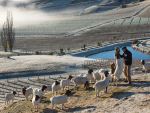Biosecurity NZ urges vigilance for yellow-legged hornets
Biosecurity New Zealand says Kiwis should continue to keep an eye out for yellow-legged hornets (Vespa velutina) over the holiday season.
During August, I will be on the road attending the Spray Days events around the country.
The main aim of the biosecurity session at Spray Days is to help members who would like assistance developing a biosecurity plan for their vineyard. I have copies of New Zealand Winegrowers' (NZW) biosecurity resources to give to members who attend these sessions.
Biosecurity planning should be a reasonably straightforward process for members who have not completed a plan before. Working through the biosecurity plan template and seeing where you can improve awareness, processes, and seeing where you can improve awareness, processes, and infrastructure should take no longer than an hour or two at the most. Implementation can be undertaken over time, allowing time to budget for any costs that may be incurred.
Biosecurity is about protecting New Zealand from the risks posed by unwanted pests and diseases. All NZW members should be a part of the biosecurity system and should be playing their role to protect our industry. Biosecurity threats could affect vineyard profitability, jobs, and the community. The next significant threat could be here already, undetected and spreading. You have the power to protect your livelihood and investments. Vineyard owners, managers, and staff need to manage risk to prevent the introduction of unwanted organisms, prevent their spread if they do arrive, and always maintain vigilance so they can be detected quickly. Growers also need to play their part in ensuring people who come onto the vineyard, such as contractors, tradespeople, and other visitors, are aware of any biosecurity risks they might pose or encounter.
The Vineyard Biosecurity Plan template has been created as a resource for NZW members to aid with development of a plan. It outlines current best practices in a range of key areas. However, each vineyard is different, as is the level of risk each manager or owner will be comfortable with accepting. Growers should develop a plan for their site consistent with the level of biosecurity risk management they wish to implement, which addresses the key risks for their vineyard. Informed risk management is key to successful biosecurity management.
Growers can control the entry of pests and diseases onto their vineyard by taking steps to manage the movement of people, vehicles, machinery, stock, seeds, and plant material as they pass through the vineyard gate. The Vineyard Biosecurity Plan template will enable you to develop a plan to help protect your vineyard against a biosecurity incursion and to identify an incursion quickly if it happens.
The template is broken down into nine actions. It links with the Vineyard Biosecurity Guidelines for Best Practice, which is also available and is designed as a training aid for vineyard staff and contractors.
The nine actions in the Vineyard Biosecurity Plan template are:

The end of the year is fast approaching, so here are some thoughts on a few of the significant developments…

OPINION: When I moved to Marlborough two decades ago, I found countless lines of tidy vines, neatly mowed and carefully…
The large 2025 harvest will exacerbate the wine industry's "lingering" supply from recent vintages, New Zealand Winegrowers Chief Executive Philip…
If you find a new consumer in a developed wine market, you are taking them from someone else, says Blank…
OPINION: Sauvignon Blanc was famously introduced to New Zealand by Ross Spence of Matua Valley, and then serendipitously planted in…